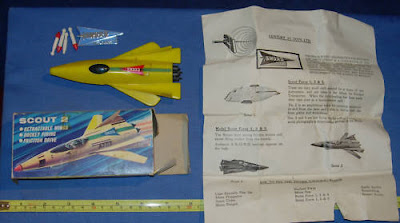Ever since Bill posted this fabulous black and white picture from TV21 showing what is probably the origin of Project SWORD's Scout 2 I have tried to find out more about the mystery space ferry.
Here are the responses to my most recent enquiries to NASA and other space agencies from last December. Interesting though they are, the TV21 space ferry remains unidentified. How did TV21 get hold of a photograph of what appears to be space plane which, as yet, no agency can put a name to? What do you think readers?
Peter Merlin
Dryden FRC History Office
USA
Between 1964 and 1968, engineers at the Air Force Flight Dynamics Laboratory (AFFDL) led by Alfred C. Draper studied a variety of lifting-body and wing-body shapes in an attempt to find the optimum configuration for a manoeuvring reentry vehicle to meet Air Force requirements.
Many of these shapes were tested as wind tunnel models, but none were pursued any further. Some of the designs were fixed-geometry concepts with low lift-to-drag ratios. Others were variable-geometry concepts with pop-out wings for use during approach and landing manoeuvres. The 1967 illustration appears to show several of the AFFDL concepts.
In the early development of hypersonics, these shapes apparently
represented an evolutionary dead end. The Between 1963 and 1968, Draper group
studied a wide variety of fixed geometry and variable sweep configurations, as
well as "interference' configurations that had complex undersurface designs to
position shock flow for favorable increases in lift, but which aggravated
aerothermodynamic problems.
"It worked," Draper recalled, "but not to a
sufficient degree to make it worth your while."
The Draper group favored simple configurations with optimized aerodynamic
tailoring. This is undoubtedly why the focus shifted almost entirely to lifting
bodes for a considerable time.
For additional information, you might wish to look for "The Hypersonic
Revolution: Case Studies in the History of Hypersonic Technology," a
three-volume set edited by Dr. Richard P. Hallion. It was published by the Air
Force History and Museums program in 1998.
*
Julia
UK Space Agency
We've never seen the concept before
and think that it is probably only a design and not reality. Swing wings ( to
improve low speed flight performance with the wing un swept and then swept for
high speed flight) were a popular idea in the late sixties/early
seventies. Our Director of Space
Science said that he wishes he still had his copies of TV21 as they are worth a
fortune now...
*
Paul E. Ceruzzi
Smithsonian
Chair, Division of Space History
National Air and Space Museum
Washington, DC
National Air and Space Museum
Washington, DC
So far no one in our Division has
come up with any information. There were several proposals for a retractable
wing for the Space Shuttle as it was being planned, but the concept was
rejected. It is a sound concept from an engineering standpoint and may be
resurrected in the future. The drawings we have for such a Shuttle do not look
like the one you have, unfortunately.
*
Colin A. Fries
Primus Solutions, Inc.
A Subsidiary of ASRC Federal
NASA HQ History Program Office
The
closest I can come is the space ferry concepts by Darrell Romick of Goodyear in
the 1950s. See attached.
So readers, we are not that much firther forward. Can anyone else add anything further to this search?


























